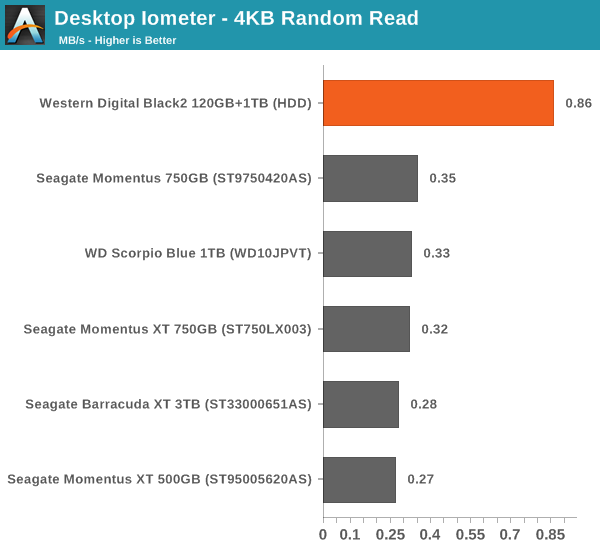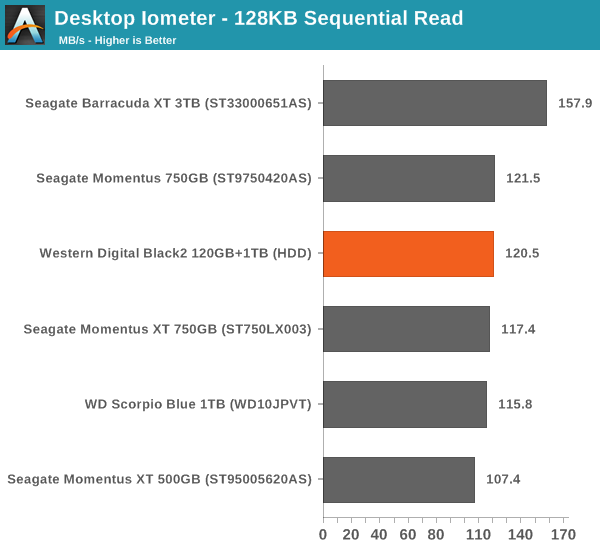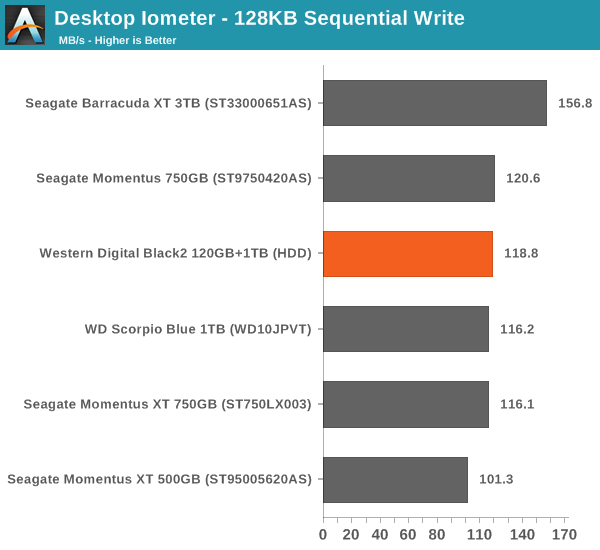The WD Black2 Review: World's First 2.5" Dual-Drive
by Kristian Vättö on January 30, 2014 7:00 AM ESTRandom & Sequential Performance - HDD
The HDD performance is average, though that shouldn't surprise anyone as there hasn't been any major breakthrough in hard drive technology. The performance is still dictated by platter density and spindle speed, which puts the Black2 at the upper end with its two 500GB 5400rpm platters. I should note that as there is no way to test the hard drive partition of the Black2 as a raw disk like we usually test drives, I had to create an NTFS volume for testing. It's possible that there is some OS prefetching/caching going on, giving the Black2 an advantage especially in the random IO tests.














100 Comments
View All Comments
azazel1024 - Thursday, January 30, 2014 - link
That is ridiculously high power consumption. I know these aren't targeted at tablets, but DANG!A 45whr notebook though, with a 6hr run time averages 7.5w of power consumption. Drop one of these "bad boys" in it, and assuming it was some kind of really low power consumption drive before, you are talking maybe an extra watt of power consumption. Doesn't sound like much, but that drops it from 6hrs of run time to 5 1/2hrs. If the run time was even longer before, say 8-10hrs, you might be knocking an entire hour of time time off...without ever using the drive at all (which would be worse).
DanNeely - Thursday, January 30, 2014 - link
That "ridiculously high power consumption" you're complaining about is normal power consumption for a 2.5" spinning drive. Unfortunately Kristian didn't put power numbers from an ordinary 2.5" spinning drive into the table to make that clearer.jmke - Thursday, January 30, 2014 - link
major issue would reliability and backup.If you have separate SSD en HDD disk, you can backup that 120GB SSD OS/Apps installs easily to the larger HDD. In case of SSD failure, RMA, new one, restore. In case of HDD failure, replace, copy content back or restore from other backup.
With the SSD-HDD combo, failure of either one SSD, HDD, makes the product useless.
this product was so not thought out.
Maltz - Thursday, January 30, 2014 - link
This drive is for people who only have space for one device. They could not backup from an SSD to an HDD because they have to pick one or the other. With this drive, they can have most of the advantages of two internal drives, but they would still require an external drive to back up to whether their internal drive was this drive, an SSD or an HDD.MF2013 - Thursday, January 30, 2014 - link
Today I got an email from Newegg that the ADATA 512GB MLC SSD is $260 with free shipping. See the drive here:http://www.newegg.com/Product/Product.aspx?Item=N8...
So this article's description of the prices of 500~GB class SSD's is, if anything, generous to the WD Black2. You can, right now, get a 512GB MLC SSD for $30 less than the Black2. The pricing is really going to have to improve for this to be a smart option for a substantial number of people.
Hrel - Thursday, January 30, 2014 - link
This is stupid and makes no sense.Either give me a hybrid caching drive with 24-32GB on NAND. (Value option)
Or give me an m-SATA SSD with a 2.5" hdd. (Performance option)
I don't want some shitty SSD, super slow, paired with a sub par hdd for MORE than I'd spend on the damn performance option.
WD this makes no sense.
Hrel - Thursday, January 30, 2014 - link
I want to see 1TB and 2TB laptop drives paired with 24GB of on board NAND for SSD caching. Seagate has the right idea, they just aren't using enough NAND yet.piroroadkill - Friday, January 31, 2014 - link
I absolutely agree. Seagate are insane. They're sitting on the correct technology, but they haven't gone far enough.They have attractive 7200 RPM 3.5" 2TB desktop drives with 8GB NAND that are excellent. If only that was 32GB or so, it would make the world's best Steam drive, caching the last few games you played in NAND at all times.
For a laptop, I'd like to see the same, really. 1TB drive with 32GB NAND. They could provide some real SSD competition.
Hrel - Tuesday, February 4, 2014 - link
So we just disagree on amount of RAM. According to Intel's testing return on investment drops off heavily beyond 20GB. Which is why I feel 24GB would be the right amount. More obviously wouldn't hurt. I mean, in terms of actual cost we're talking a few dollars. If the retail price difference between the two options was <$20 then I'd say do the extra and use around 30GB. But since it's already a low margin product that few dollars could be the difference between in making sense to pursue the product and it not making sense. Weighed against the minimal performance advantage of an additional 8-12GB of NAND I'd say 24GB is the correct choice. That's already 4GB over price/performance sweet spot.MichaelD - Thursday, January 30, 2014 - link
Interesting product and useful...to a point. What I'd like to see is this drive with the option to use it as is OR with the two drives (SSD and HD) as physically separate drives. One power connector, but TWO SATA connectors. You could have a small jumper on the drive or a tiny switch or even program it through a FW update or similar software mechanism.